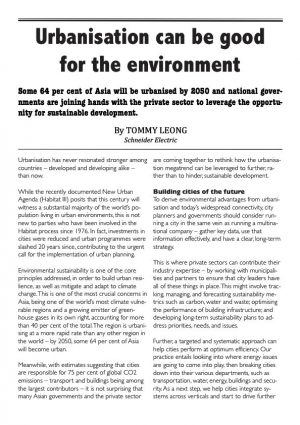 Urbanisation has never resonated stronger among countries – developed and developing alike – than now.
Urbanisation has never resonated stronger among countries – developed and developing alike – than now.
While the recently documented New Urban Agenda (Habitat III) posits that this century will witness a substantial majority of the world’s population living in urban environments, this is not new to parties who have been involved in the Habitat process since 1976. In fact, investments in cities were reduced and urban programmes were slashed 20 years since, contributing to the urgent call for the implementation of urban planning.
Environmental sustainability is one of the core principles addressed, in order to build urban resilience, as well as mitigate and adapt to climate change. This is one of the most crucial concerns in Asia, being one of the world’s most climate vulnerable regions and a growing emitter of greenhouse gases in its own right, accounting for more than 40 per cent of the total. The region is urbanising at a more rapid rate than any other region in the world – by 2050, some 64 per cent of Asia will become urban.
Meanwhile, with estimates suggesting that cities are responsible for 75 per cent of global CO2 emissions – transport and buildings being among the largest contributors – it is not surprising that many Asian governments and the private sector are coming together to rethink how the urbanisation megatrend can be leveraged to further, rather than to hinder, sustainable development.
Building cities of the future
To derive environmental advantages from urbanisation and today’s widespread connectivity, city planners and governments should consider running a city in the same vein as running a multinational company – gather key data, use that information effectively, and have a clear, long-term strategy.
This is where private sectors can contribute their industry expertise – by working with municipalities and partners to ensure that city leaders have all of these things in place. This might involve tracking, managing, and forecasting sustainability metrics such as carbon, water and waste; optimising the performance of building infrastructure; and developing long-term sustainability plans to address priorities, needs, and issues.
Further, a targeted and systematic approach can help cities perform at optimum efficiency. Our practice entails looking into where energy issues are going to come into play, then breaking cities down into their various departments, such as transportation, water, energy, buildings and security. As a next step, we help cities integrate systems across verticals and start to drive further efficiencies from the whole. The idea is to generate savings that cities can then use to improve education and other elements of city life.
There’s nothing stopping cities from starting to make the change to become more liveable, more efficient, and more sustainable. In fact, it’s paramount that they do it if they want to keep up with urbanisation trends and ensure that the world holds warming to no more than 2⁰C.
The good news is that many Asian cities are actively evolving and innovating in using smart technologies to achieve the goals of sustainability, liveability, and responsiveness, and their efforts can be seen in three key areas – buildings, water and energy.
Smart buildings
According to the United Nations Environment Programme, energy consumed by buildings has grown to around 40 per cent of total consumption worldwide.
Studies have shown that only a quarter of a building’s costs are associated with capital expenses. The remaining three-quarters go toward operating a building over its lifecycle. Moreover, energy use in buildings is only going to rise – the International Energy Agency predicts energy demand will increase by 50 per cent by 2050.
Integrated building management solutions are an excellent way to enable smart, sustainable ecosystems inside and outside of buildings, while even new and existing government buildings can be transformed into energy efficient buildings.
For instance, the Prime Minister’s Office in Malaysia achieved 40 per cent of energy savings and is certified the platinum status of Malaysia’s green building standard, the Green Building Index (GBI), after adopting our Building Automation and Energy Monitoring System. This retrofitting project simultaneously helps Malaysia meet their Copenhagen promise to reduce 40 per cent carbon emissions by 2020.
Solutions with a combination of software and hardware would provide greater levels of insight and analysis using energy and operational data; as a result, building owners and operators gain a better understanding of their physical assets and can save up to 30 per cent on energy costs.
Smart water
In many Asian cities, the combination of population growth and a sharp increase in demand for energy and manufacturing has major repercussions on water as a resource. The World Bank forecasts a global deficit of 40 per cent between anticipated demand and available water resources by 2030.
Smart water solutions such as improving water management systems and networks, preventing and reducing leaks, and optimising processing are critical to address this challenge.
When implemented in East Water’s water pipe network – Thailand’s most advanced, efficient and complete water pipeline at approximately 400km long – such solutions reduced water loss in the pipeline from 20 per cent to 3 per cent, and reduced energy consumption by 5 per cent.
Smart energy
Energy demand in Asia looks set to double in the next 15 years, with the growth in demand largely concentrated in the region’s cities. Since fossil fuels remain the main source of Asian cities’ power, generating electricity in a sustainable way poses a great challenge.
Thankfully, the growth in alternative sources of energy has created new opportunities for governments and companies in Asia to integrate renewable energy sources such as solar and wind with smarter upgrade projects across the region.
One such example is the San Lorenzo Wind Farm, which is part of an effort to give greater emphasis to the use of more sustainable energy sources in the Philippines. It adopted an end-to-end solution that protects the wind farm from many system faults and ensures reliable production all-year round, especially as it is projected to generate over 120 GWh of electricity annually and be capable of sustaining the energy demands of 48,000 households.
Smart grid solutions are also playing a central role in transforming the power industry. By letting businesses know how much power they are using, the machines involved and the costs every minute of the day, you provide them with the necessary tools to measure and reduce energy consumption.
Companies are leveraging the use of Internet of Things (IoT) and smart grids to build more efficient energy infrastructure in cities. When electrical systems of buildings are connected to smart grids, the grids detect power usage in different parts of the city and divert power to places where it is needed most.
As urbanisation rapidly transforms the face of Asia and the lives of its citizens, everyone from policy makers to companies and residents have an important role to play in ensuring that the benefits that urban expansion brings is efficient, inclusive and sustainable – that Life is On for everyone, everywhere at every moment.
Tommy Leong
Originally published
by eco-business.com
February 27, 2017


